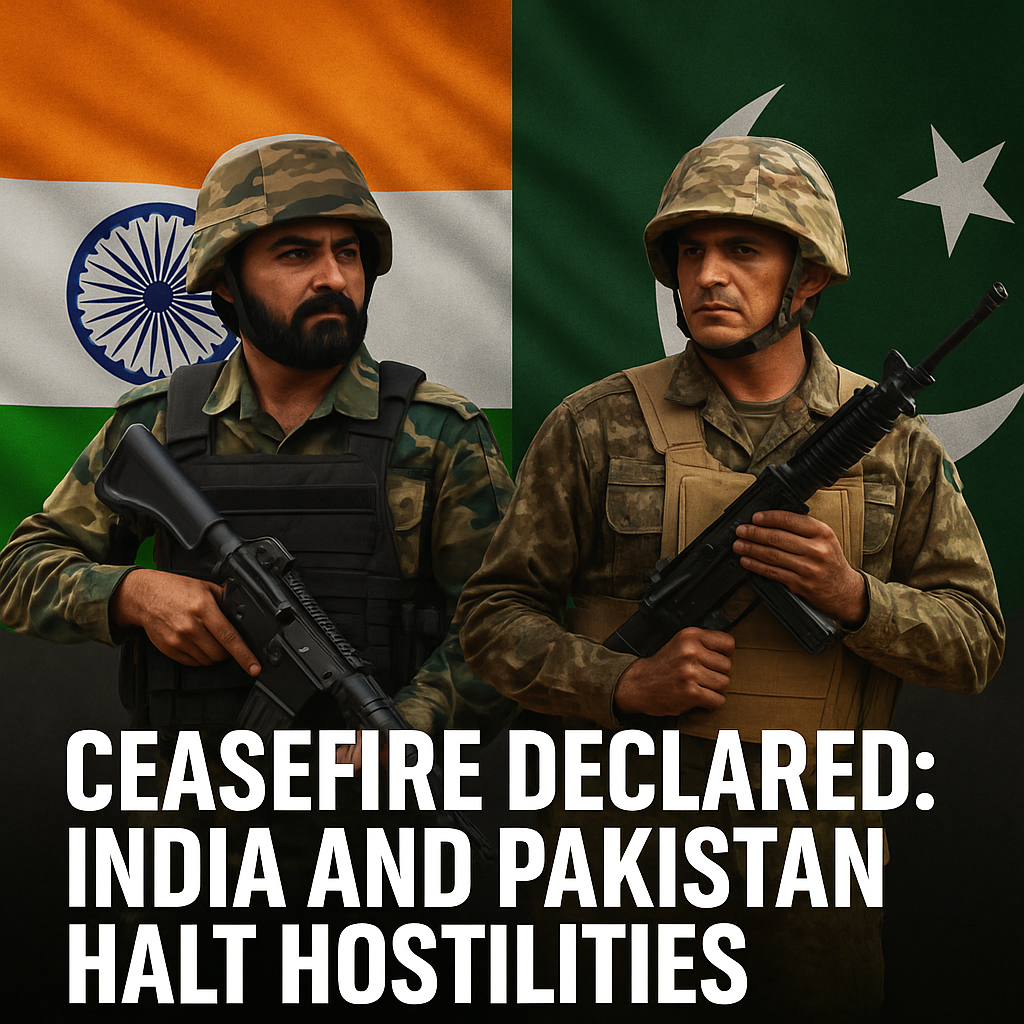In a significant diplomatic development, India and Pakistan have agreed to a full ceasefire, putting an end to hostilities on land, sea, and air.
Ceasefire Declared: India and Pakistan Halt All Military Action
The announcement was made by Indian Foreign Secretary Vikram Misri on May 10, 2025, confirming that the Directors General of Military Operations (DGMOs) from both sides had reached a mutual understanding. The ceasefire took effect at 5:00 PM IST the same day.
This decision followed a direct call from Pakistan’s DGMO to his Indian counterpart at 3:35 PM. The communication between the two military leaders concluded with explicit instructions for cessation of all forms of firing and aerial or maritime military operations. They are scheduled to resume communication on May 12 at noon for further discussions. The announcement came shortly after U.S. President Donald Trump revealed that the ceasefire was the outcome of intensive, U.S.-mediated negotiations. The U.S. President congratulated both nations, emphasizing the importance of using diplomacy over conflict.
India’s military and political leadership confirmed full adherence to the agreement, signaling a potential thaw in the most recent escalation that had placed the region on high alert.
Civilian Resilience in Kashmir Amidst Airstrikes and Drone Threats
As military exchanges intensified in early May, Jammu and Kashmir, particularly Srinagar and South Kashmir, became key targets for attempted strikes. Drone intrusions aimed at installations like the Srinagar airport and the Awantipora air base were intercepted successfully, preventing casualties and infrastructural damage. Sirens and mosque loudspeakers warned residents to keep lights off at night to avoid becoming targets, a haunting reminder of the vulnerability civilians face in conflict zones.
Skies on Fire: Pakistan’s 36 Strikes in One Night Draws Global Attention to Turkey’s Songar Drones
Despite the threat, life in Srinagar showed remarkable resilience. People gathered on streets, discussing the India-Pakistan standoff with a sense of calm and composure. The sentiment in the valley, even during heightened tensions, leaned toward a collective hope for enduring peace. Residents expressed that while they were accustomed to such disruptions, their ultimate desire was for a sustainable resolution and not just a temporary pause in conflict.
The announcement of a ceasefire has been met with cautious optimism. People in Kashmir know the value of peace more intimately than most. For them, every declaration of ceasefire brings a sliver of hope—for families to reunite, for schools to reopen, and for life to return to normalcy.
Political and Diplomatic Reactions: From Tamil Nadu to the United Nations
Political figures across India welcomed the ceasefire. Tamil Nadu Chief Minister M.K. Stalin praised the truce as a “welcome step,” expressing solidarity with the Indian Armed Forces and hoping peace would endure. In Jammu and Kashmir, Chief Minister Omar Abdullah also expressed support for the ceasefire, though he lamented the delay that, according to him, led to unnecessary loss of life. He emphasized the urgent need for compensation and support for those injured or displaced during the conflict.
Internationally, the ceasefire announcement gained swift recognition. U.S. Secretary of State Marco Rubio disclosed that intense diplomatic conversations had taken place with senior Indian and Pakistani officials, including Prime Ministers Narendra Modi and Shehbaz Sharif. The involvement of Vice President J.D. Vance and top military advisors underscored the seriousness with which the United States treated this flashpoint.
Nuclear Flashpoint: India Strikes, Pakistan Retaliates, Region Trembles
The United Nations, through Deputy Spokesperson Farhan Haq, expressed approval of all de-escalation efforts. Former Indian diplomats, including Ashok Sajjanhar, noted that the ceasefire reflected Pakistan’s inability to sustain prolonged military engagement. They pointed to the economic and geopolitical pressure on Islamabad, making de-escalation a strategic necessity rather than a concession.
Strategic Outcomes: Military Losses, Misinformation, and Regional Stability
As is common during high-intensity conflicts, claims and counterclaims flooded the media landscape. Reports from Pakistan’s side alleging the destruction of India’s advanced defense assets—including S-400 systems, BrahMos missile sites, and the hypothetical F-4100 base—were officially dismissed by Indian military spokesperson Colonel Sofia Qureshi as “fabricated and baseless.” She reaffirmed that no Indian strategic assets were compromised and highlighted the significant damage inflicted on Pakistan’s air defenses and drone fleets in retaliatory strikes.
One of the most notable outcomes of India’s targeted strikes was the elimination of Yusuf Azhar, a senior Jaish-e-Mohammed commander and a mastermind of the 1999 IC-814 hijack. His death in a precision strike on May 7 in Bahawalpur marked a major blow to the terror infrastructure supported across the border. Officials confirmed that Yusuf, who was on India’s most-wanted list for decades, had orchestrated several terror attempts and was directly linked to JeM founder Masood Azhar.
The reopening of Pakistani airspace and the resumption of civilian flight operations signaled a step toward normalization. The Pakistan Airports Authority confirmed that all airports were back in service, restoring a semblance of normal life for thousands of travelers affected by the conflict-induced closures.
Counterterrorism Only: U.S Blocked Pakistan’s F-16s from War Use Against India
While the ceasefire does not solve deeper geopolitical and ideological divides, it provides an opening. It gives the region a moment to breathe, reflect, and possibly redirect its energies from confrontation to cooperation. The DGMOs’ scheduled follow-up talks on May 12 will be crucial in shaping what comes next.

